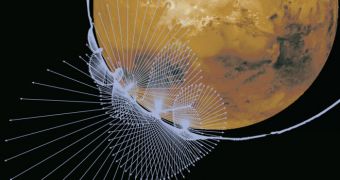A recent study proves that the difference of landscape between the northern and the southern hemispheres of Mars, as well as the concentration of the planet's magnetic field in the southern hemisphere, could have been caused by the same giant collision.
There are still intriguing questions related to our red neighbor, but one of them seems to have gotten its answer. It implies the association of two major aspects of the planet: its strange landscape and its even weirder magnetic field. The landscape suffers from a bad case of dichotomy: the northern hemisphere is characterized by a smooth, almost flat surface, situated about 6 km (3.73 miles) under the level of its mountainous southern counterpart, a phenomenon which is believed to have been caused by a major impact. As for the magnetic field, observed for the first time by Mars Global Surveyor in 1985, it is wholly concentrated in the southern hemisphere of the planet. It has also been acknowledged that the two characteristics originated during about the same period of the planet's history.
This is why Sabine Stanley from the University of Toronto in Canada wondered whether they were not somehow related, possibly even caused by the same event. And since there was an event that explained the occurrence of the collision, why wouldn't it also explain the other? Thus, her study focused on linking the asymmetrical magnetic field to the huge collision that caused the shape of the Martian landscape. In this respect, Stanley and her team used computer-generated models to observe the heat's motion within the planet during the aftermath of the shallow impact with the object almost as big as our moon.
They discovered that the collision warmed the mantle (the half-molten layer under the planet's crust) of Mars' northern half, lowering the difference in temperature between it and the core. As Stanley explains, “This warmer material results in less heat flowing across the core-mantle boundary in the northern hemisphere”. By comparison, the strong heat exchanges caused by core-mantle temperature differences in the southern hemisphere agitate the magnetic mineral-containing rock in the mantle. Obviously, the motion of the molten magnetic rock in convection currents leads to the occurrence of a self-dependent magnetic dynamo. “Since the generated magnetic field is only strong in the southern hemisphere, only the rocks in the southern hemisphere become strongly magnetized,” adds Stanley as a conclusion to her theory.
While admitting that the research will have to go further into some details, Jeff Andrews-Hanna from the Colorado School of Mines, the very one who came up with the theory of the oblique impact that gave the Martian landscape its strange shape, is impressed by Stanley's conclusions. As he states, the research “offers a very interesting and compelling solution. Mars presents us with many mysteries, but as time goes on more of the pieces of the puzzle seem to be falling into place”.

 14 DAY TRIAL //
14 DAY TRIAL //